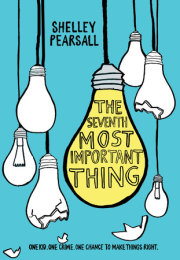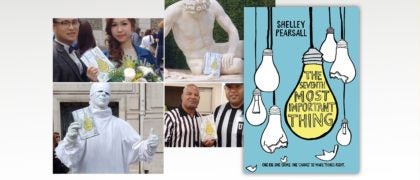One
On a bitter November day in Washington, D.C., when everything felt metallic--when the sky was gray and the wind stung and the dry leaves were making death-rattle sounds in the alleys--thirteen-year-old Arthur Owens picked up a brick from the corner of a crumbling building and threw it at an old man's head.
It wasn't an accident. The brick didn't topple off the decrepit building. It didn't fall from the heavens. Arthur Owens grabbed the brick with his own hands. He held it for a minute, noticing the cold weight of it--and then he raised his arm and flung it at the old trash picker known as the Junk Man, who was pushing a rusty grocery cart down the street.
Lucky for Arthur Owens, it was a windy day and his ability to see things at a distance had never been good. Also, the front wheel of the grocery cart wobbled off the sidewalk at precisely the right moment. As the old man leaned to straighten the cart, Arthur's brick slammed into his shoulder, sending him crumpling to the ground and the grocery cart skidding into the street.
If it hadn't been for the wind and the wobbly cart and Arthur's bad aim, it could have been a lot worse, everybody said. In the hospital later, the Junk Man told a newspaper reporter he believed it was an act of God.
"You being saved?" the reporter asked, already jotting down the answer he expected to hear.
"No" was the Junk Man's odd reply. "Me being hit."
Those were the facts. On November 9, 1963, the story ran in all three of the city's newspapers. One headline read: THIRTEEN-YEAR-OLD BOY ATTACKS CITY MAN. Then, in smaller type below, it said: Man Saved by Good Samaritan.
Most people didn't care much about the facts, though. They didn't care about the particular place where the crime happened--not a bad neighborhood, but not a good one either. Or how a newspaper delivery truck driver who'd taken a wrong turn spotted the injured man on the sidewalk and rushed him to a nearby hospital.
What everybody wanted to know was why.
Arthur Owens spent three weeks in the Juvenile Detention Home, better known as juvie, asking himself the same question.
Two
A lot happened during the three weeks Arthur was locked up--the worst being that President Kennedy was killed. Then the guy who killed President Kennedy was killed. And then the Thanksgiving holiday passed by without much mention in juvie or anywhere else. Arthur didn't mind missing it. Along with the rest of the world, he didn't have much to be thankful for.
Four days after Thanksgiving, Arthur was brought to the courthouse for the hearing that would decide his fate. He was seated in a long row of bad kids, so he figured it was going to be a while.
Unfortunately, the judge assigned to hear Arthur Owens's case was not a listening sort of man. Judge Philip Warner liked his billowy black robe and the sound of his own voice too much. He reminded Arthur of those big horseflies that get stuck in your window in the summertime and buzz like mad and won't quit no matter what you do.
As the morning dragged on, the temperature in the courtroom rose. If Arthur had ever wondered what the fires of hell were like, Judge Warner's courtroom was giving him a pretty good idea. People who had come in wearing their winter coats and wool suit jackets were down to their shirtsleeves.
Arthur kept his suit jacket neatly buttoned and his sleeves down. He knew it was what his mom would want.
Doing his best to stay awake, he tried to focus on the walls of the courtroom, which were covered with vertical panels of grooved wood. Arthur thought maybe the design was supposed to make the room appear sleek and modern, but the longer he stared at the panels, the more they seemed to ripple in sickening waves. He began to believe that even the walls had been designed as a kind of punishment.
The combination of all these things--the swimming walls, the heat, the sweat, and the judge's endless voice--made him feel as if he just might puke when his turn finally came.
"Arthur T. Owens, approach the bench," the bailiff called out.
It was only a few steps from his chair to the judge's bench, but to Arthur it felt like miles. He could sense the breathing, sweaty mass of people behind him the way you sense the weight of bullies right before they're about to smash you into a wall of lockers at school.
There had been a lot of bullies in juvie--it was practically a bully vacation spot.
No doubt some of the people in the courtroom were surprised to see what Arthur Owens looked like as he walked to the front. He wasn't your typical juvie thug. He didn't have meat slabs for hands, or full facial hair, or an insolent grin.
He thought he could hear a few whispers behind him. "That's him?"
Arthur Owens was slender, pale, and moody-looking. Maybe he was a little taller than some thirteen-year-olds--his father had been tall--but mostly, he was someone who wouldn't get noticed walking down the street. When his brown hair flopped over his eyes, Arthur had the bad habit of leaving it there, which drove his mother crazy. He also didn't smile much.
As Arthur glanced nervously at the long row of juvenile delinquents, he could tell he was one of the youngest of all the young criminals waiting on the judge that day. And from what he could see, he was the only person who was wearing an almost-new funeral suit that didn't fit him very well.
Three
Judge Warner took a moment to study Arthur Owens when he reached the bench. It was his way of making the kids squirm.
As the judge glared at him, Arthur tried to decide what to do with his hands and feet, which suddenly seemed to be completely useless objects. He crossed and uncrossed his arms, shifted from one foot to the other, and did his best to ignore the sickening flip-flopping in his stomach. Sweat made his undershirt stick to his back.
The judge finally spoke after glancing down at a piece of paper handed to him by the bailiff. "You are Arthur Thomas Owens?"
"Yes," Arthur thought he said.
"I didn't hear you, young man."
"Yes, Your Honor," Arthur replied, slightly louder.
"Look up at me when you are speaking."
Arthur swallowed. He hated looking at people when he was speaking. It made him feel like they could X-ray every thought in his head. Usually, he had his hair to hide behind, but that morning his mother had taken a pair of scissors to the front of it. "To make you look less guilty," she'd told him.
Arthur didn't think his hair had anything to do with his guilt, but there was nothing left now but a jagged fringe high above his forehead. He tugged at it with his fingers.
"Okay," he mumbled, glancing up at the judge's thick round glasses and oddly magnified eyes, then looking back down at his feet. There was a long pause, as if the judge was trying to decide if he was entitled to more respect than he was getting. The room was quiet, expectant.
When the judge's gaze finally returned to the paper in his hands, Arthur held back a loud sigh of relief.
"According to what I've read about your case, I understand you attacked a man named James Hampton in a vicious and unprovoked manner on November eighth. Is that correct, Mr. Owens?"
Arthur blinked, momentarily confused by the name.
James Hampton? Who was James Hampton?
It took him a minute to figure out the judge was talking about the old Junk Man. Arthur tried not to look surprised by the fact that the man had a real name.
Everybody had a name, of course, but he had to admit he'd never thought about the Junk Man having one. He couldn't recall anybody in the neighborhood ever using it--especially not a name as formal-sounding as James Hampton, which could have belonged to a school principal or somebody's grandfather.
It definitely didn't make Arthur feel any better about what he'd done.
It also didn't make him feel better to find out that the Junk Man--James Hampton--had come to court that day to watch what happened. He was seated in the crowd only a few rows back from where Arthur stood.
The judge pointed him out. A shocked breath caught in Arthur's throat.
He didn't even look like the same person.
The Junk Man's gray-white hair, usually disheveled, was now close-cut and carefully trimmed. He wasn't wearing his familiar raggedy clothes and foggy eyeglasses either. Instead, he had on a neatly pressed brown suit and striped orange tie. Somehow he appeared taller. And less crazy.
But you couldn't miss the heavy white cast covering one arm and the sling of fabric that formed a triangle, almost like the letter A for Arthur, across the old man's chest.
Arthur swallowed hard, staring at the cast, staring at what he'd done. The A seemed to get more visible, more accusing, the longer he stared at it.
"Mr. Owens, I'll repeat my question. Are you the one who attacked Mr. Hampton?"
"Yes, sir," Arthur whispered.
"Then I want you to look at this innocent man you injured--and, quite frankly, could have killed," the judge continued.
There was a murmur of outraged agreement in the courtroom.
"And I want you to tell me what was going through your mind that afternoon," said the judge, his voice rising. He was proud of his intimidating, kid-shaking baritone. "I want to know exactly what could have compelled you to throw a brick at Mr. Hampton as he was minding his own business walking down the street."
Arthur was silent. He looked at his feet. The too-long funeral pants made pools of black fabric over his polished shoes. He noticed how the orange carpet below them was nearly the same shade as the Junk Man's tie. He wondered if he'd be sentenced to jail for life if he refused to give a reason for what he'd done.
"Did you attack Mr. Hampton because he looked like a helpless old man--pardon my choice of words," the judge added apologetically, glancing in the direction of the Junk Man. "Did he seem like an easy target to you?"
"No, sir," Arthur heard himself answer reluctantly.
"Were you attempting to rob him?"
Arthur shook his head. Robbing the Junk Man would have been an almost-funny statement in any other place, but he didn't dare laugh, not even inside his own head.
"Was it his color that caused you to attack him?"
Color? Confused, Arthur turned to look at the Junk Man again, not sure what color the judge was referring to. Was he talking about the white cast? The orange tie?
The judge grew more impatient. "I am asking you, young man--and this is a very serious question--did you throw the brick at him because he is a black man?"
What? Arthur's stomach gave a sickening lurch. This was a possibility he'd never thought about. Never in a million years considered. He could feel his heart thudding wildly, his mind racing. The Junk Man wasn't a color. He was just the Junk Man.
But the man's skin was light brown. That was a fact.
And Arthur's was peeled-onion white. That was a fact too.
He'd just never put those two facts together.
Arthur knew people's race wasn't something you messed around with. There were marches and protests about it on television all the time--and Arthur didn't even pay much attention to the news. Could the judge truly believe he'd been trying to stir up some kind of trouble by hitting the Junk Man?
Although he had sworn to himself that he would say nothing--that he would never talk about what had made him so angry on that November afternoon--Arthur had no choice. His father wouldn't have wanted him to stay silent and be accused of something far worse.
So Arthur licked his dry lips and spoke.
"Your Honor," he said, trying to keep his voice from shaking. "It wasn't his color."
The judge's reply was icy. "Then what was it?"
Arthur knew the answer would sound crazy to everyone in the room. He knew no one would understand, and it would probably earn him a permanent bunk in juvie with nothing but olive-green clothes and bad food and lukewarm showers for the rest of his life.
Looking down at the floor, Arthur said in a barely audible voice, "It was because of his hat, Your Honor."
While this might have seemed like a smart-aleck answer to the judge, to the courtroom, and to anyone who heard it, it was, in fact, the truth. Arthur had thrown the brick because of a hat.
Four
The hat in question had been missing from the hall closet, along with everything else that had belonged to his father, when Arthur got home from school that November day. It was November 8, just as the judge had said. A Friday.
Arthur remembered opening the closet to hang up his stuff. He'd just taken off his coat and tossed his shoes inside when he realized something was different. The closet was tidy and half empty. It smelled like Murphy's oil soap.
With his heart hammering in his chest, he began pushing through the coats that were left, searching for his father's old corduroy jacket. It was a big, faded coat that held the shape of his father's shoulders and smelled of stale cigarette smoke and beer and motor oil, as if he'd just taken it off after getting home from work. (Arthur still liked to imagine that he had.)
Nothing.
Arthur's eyes darted toward the row of hat pegs, looking for the motorcycle cap that had belonged to his father. It was one of those slick Harley-Davidson caps--black leather with a silver chain and the orange-winged logo on the brim.
If you wanted to find Tom Owens in a crowd, all you had to do was look for that cap, sitting slightly to one side--never straight, always jaunty. He was wearing it in nearly every picture the family had of him.
But except for the one with his little sister's pink knit hat, all of the pegs were empty.
Feeling more and more uneasy, Arthur pounded up the stairs to his parents' room, making the walls of the small house shake. He and his sister shared one room at the top of the stairs. His parents shared the other. Both rooms were shabby. Arthur's family had never had a lot of money.
The door to his parents' room stood open. Arthur saw that the old radio his dad used to listen to ball games on was missing. The wedding picture that had always been on his parents' wall was gone. Even the ashtray on the windowsill--the one he'd made for his dad in art class in third grade, a hideous green-and-blue swirl of clay--wasn't there.
Copyright © 2015 by Shelley Pearsall. All rights reserved. No part of this excerpt may be reproduced or reprinted without permission in writing from the publisher.










